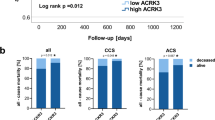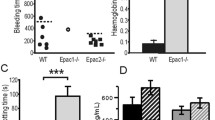Abstract
Background: The role of α2-antiplasmin (α2-AP) on platelet aggregation was investigated using mice deficient in α2-AP (α2-AP−/−) or using wild type mice (α2-AP+/+).
Methods: Blood samples were taken from each mouse under anesthesia with ether and platelet rich plasma (PRP) was prepared. Platelet aggregation induced by various doses of ADP (0.3–30 μM) was detected using a laser-light scattering (LS) system. Aggregated forms were observed using a scanning electron microscopy (SEM).
Results: Dose-dependent platelet aggregation was not different in both types of mice. However, platelet micro-aggregate formation in α2-AP−/− mice induced by low dose of ADP (1.0 μM) markedly increased compared to the situation in wild type mice. Aggregated form detected by SEM showed supported data from LS analysis. When washed platelets of α2-AP+/+ mice were resuspended in plasma of α2-AP−/− mice, platelet micro-aggregation was also increased. On the contrary, when washed platelets of α2-AP−/− mice were suspended in plasma of α2-AP+/+ mice, platelet micro-aggregation did not change. In separate experiments, tPA (1.0 μg/ml) was added to PRP before the stimulation of ADP. tPA had no effect on platelet aggregation in α2-AP+/+ mice, however platelet micro-aggregation in α2-AP−/− mice was markedly increased by the treatment with tPA. Moreover, the amount of released ATP from stimulated platelets was increased in α2-AP−/− mice treated with tPA.
Conclusion: Lack of α2-AP increased platelet micro-aggregation, and plasmin plays an important role in the formation of platelet aggregation when α2-AP knockout mice are used. Consequently, the reduction of α2-AP could be a risk factor for the activation of platelets resulting in thrombus formation.
Similar content being viewed by others
References
Johnson SA, Schneider CL. The existence of antithrombolytic activity in platelets. Science 1953;117:229.
Plow EF, Collen D. The presence and release of alpha 2-antiplasmin from human platelets. Blood 1981;58:1069–1174.
Collen D. Identification and some properties of a new fast-reacting plasmin inhibitor in human plasma. Eur J Biochem 1976;69:209–216.
Wiman B, Collen D. On the mechanism of the reaction between human alpha 2-antiplasmin and plasmin. J Biol Chem 1979;254:9291–9297.
Bayes-Genis A, Guindo J, Oliver A, et al. Elevated levels of plasmin-alpha2 antiplasmin complexes in unstable angina. Thromb Haemost 1999;81:856–858.
Ruggeri ZM. Mechanisms initiating platelet thrombus formation. Thromb Haemost 1997;78:611–616.
Born GV, Hume M. Effects of the numbers and sizes of platelet aggregates on the optical density of plasma. Nature 1967;215:1027–1029.
Cardinal DC, Flower RJ. The study of platelet aggregation in whole blood. Br J Pharmacol 1979;66:94–95.
Latimer P. Light scattering vs. microscopy for measuring average cell size and shape. Biophys J 1979;27:117–126.
Ozaki Y, Satoh K, Yatomi Y, Yamamoto T, Shirasawa Y, Kume S. Detection of platelet aggregates with a particle counting method using light scattering. Anal Biochem 1994;218:284–294.
Tohgi H, Takahashi H, Watanabe K, Kuki H, Shirasawa Y. Development of large platelet aggregates from small aggregates as determined by laser-light scattering: effects of aggregant concentration and antiplatelet medication. Thromb Haemost 1996;75:838–843.
Miyamoto S, Ogawa H, Soejima H, et al. Enhanced platelet aggregation in the coronary circulation after coronary spasm. Thromb Res 2001;103:377–386.
Haque SF, Matsubayashi H, Izumi S, et al. Sex difference in platelet aggregation detected by new aggregometry using light scattering. Endocr J 2001;48:33–41.
Sakamoto T, Ogawa H, Kawano H, et al. Rapid change of platelet aggregability in acute hyperglycemia. Detection by a novel laser-light scattering method. Thromb Haemost 2000;83:475–479.
Matsuno H, Kozawa O, Ueshima S, Matsuo O, Collen D, Uematsu T. The interaction between components of the fibrinolytic system and GPIb/V/IX of platelets thrombus formation in mice. Br J Pharmacol 2000;131:858–864.
Matsuno H, Kozawa O, Ueshima S, Matsuo O, Collen D, Uematsu T. Lack of tPA significantly affects antithrombotic therapy by a GPIIb/IIIa antagonist, but not by a thrombin inhibitor in mice. Thromb Haemost 2000;83:605–609.
Matsuno H, Kozawa O, Okada K, Ueshima S, Matsuo O, Uematsu T. Plasmin generation plays different roles in the formation and removal of arterial and venous thrombus in mice. Thromb Haemost 2002;87:98–104.
Lijnen HR, Okada K, Matsuo O, Collen D, Dewerchin M. Alpha2-antiplasmin gene deficiency in mice is associated with enhanced fibrinolytic potential without overt bleeding. Blood 1999;93:2274–2281.
Matsuno H, Kozawa O, Nagashima S, Kanamaru M, Uematsu T. Comparative antiplatelet effects of aspirin, vapiprost and GR144053, a GPIIb/IIIa antagonist, with a special reference to the role of platelet microaggregates. Br J Pharmacol 1999;127:1129–1134.
Prieto AR, Ma H, Huang R, et al. Thrombostatin, a bradykinin metabolite, reduces platelet activation in a model of arterial wall injury. Cardiovasc Res 2002;53:984–992.
Ishii-Watabe A, Uchida E, Mizuguchi H, Hayakawa T. On the mechanism of plasmin-induced platelet aggregation. Implications of the dual role of granule ADP. Biochem Pharmacol 2000;59:1345–1355.
Collen D, Lijnen HR. Basic and clinical aspects of fibrinolysis and thrombolysis. Blood 1991;78:3114–3124.
Coller BS. Platelets and thrombolytic therapy. N Engl J Med 1990;322:33–42.
Spinler SA, Inverso SM. Update on strategies to improve thrombolysis for acute myocardial infarction. Pharmacotherapy 2001;21:691–716.
Author information
Authors and Affiliations
Rights and permissions
About this article
Cite this article
Takei, M., Matsuno, H., Okada, K. et al. Lack of α2-Antiplasmin Enhances ADP Induced Platelet Micro-Aggregation through the Presence of Excess Active Plasmin in Mice. J Thromb Thrombolysis 14, 205–211 (2002). https://doi.org/10.1023/A:1025096609558
Issue Date:
DOI: https://doi.org/10.1023/A:1025096609558




